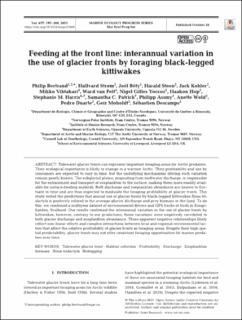Feeding at the front line: Interannual variation in the use of glacier fronts by foraging black-legged kittiwakes
| dc.contributor.author | Bertrand, Philip | |
| dc.contributor.author | Strøm, Hallvard | |
| dc.contributor.author | Bêty, Joël | |
| dc.contributor.author | Steen, Harald | |
| dc.contributor.author | Kohler, Jack | |
| dc.contributor.author | Vihtakari, Mikko | |
| dc.contributor.author | Van Pelt, Ward | |
| dc.contributor.author | Yoccoz, Nigel Gilles | |
| dc.contributor.author | Hop, Haakon | |
| dc.contributor.author | Harris, Stephanie M. | |
| dc.contributor.author | Patrick, Samantha C. | |
| dc.contributor.author | Assmy, Philipp | |
| dc.contributor.author | Wold, Anette | |
| dc.contributor.author | Duarte, Pedro | |
| dc.contributor.author | Moholdt, Geir | |
| dc.contributor.author | Descamps, Sébastien | |
| dc.date.accessioned | 2021-12-09T15:36:25Z | |
| dc.date.available | 2021-12-09T15:36:25Z | |
| dc.date.created | 2021-12-03T12:06:40Z | |
| dc.date.issued | 2021 | |
| dc.identifier.citation | Marine Ecology Progress Series. 2021, 677 197-208. | en_US |
| dc.identifier.issn | 0171-8630 | |
| dc.identifier.uri | https://hdl.handle.net/11250/2833627 | |
| dc.description.abstract | Tidewater glacier fronts can represent important foraging areas for Arctic predators. Their ecological importance is likely to change in a warmer Arctic. Their profitability and use by consumers are expected to vary in time, but the underlying mechanisms driving such variation remain poorly known. The subglacial plume, originating from meltwater discharge, is responsible for the entrainment and transport of zooplankton to the surface, making them more readily available for surface-feeding seabirds. Both discharge and zooplankton abundance are known to fluctuate in time and are thus expected to modulate the foraging profitability of glacier fronts. This study tested the predictions that annual use of glacier fronts by black-legged kittiwakes Rissa tridactyla is positively related to the average glacier discharge and prey biomass in the fjord. To do this, we combined a multiyear dataset of environmental drivers and GPS tracks of birds in Kongsfjorden, Svalbard. Our results confirmed the interannual variation in the use of glacier fronts by kittiwakes; however, contrary to our predictions, these variations were negatively correlated to both glacier discharge and zooplankton abundance. These apparent negative relationships likely reflect non-linear effects and complex interactions between local and regional environmental factors that affect the relative profitability of glacier fronts as foraging areas. Despite their high spatial predictability, glacier fronts may not offer consistent foraging opportunities for marine predators over time. | en_US |
| dc.language.iso | eng | en_US |
| dc.title | Feeding at the front line: Interannual variation in the use of glacier fronts by foraging black-legged kittiwakes | en_US |
| dc.type | Peer reviewed | en_US |
| dc.type | Journal article | en_US |
| dc.description.version | publishedVersion | en_US |
| dc.source.pagenumber | 197-208 | en_US |
| dc.source.volume | 677 | en_US |
| dc.source.journal | Marine Ecology Progress Series | en_US |
| dc.identifier.doi | 10.3354/meps13869 | |
| dc.identifier.cristin | 1964198 | |
| cristin.ispublished | true | |
| cristin.fulltext | original | |
| cristin.qualitycode | 2 |
Tilhørende fil(er)
Denne innførselen finnes i følgende samling(er)
-
Articles [3001]
-
Publikasjoner fra CRIStin [3025]
